Also, the female (hen) is much smaller, weighing about half as much as the male. They are not elegant fliers due to their body weight and short, rounded wings. While taking off they produce a sudden thundering noise that deters predators.
Because of their body size and wing span they avoid young and dense forests when flying. While flying Capercaillie birds rest in short gliding phases. Capercaillie feathers produce a whistling sound.
It is a herbivore and lives on a variety of foods including buds, leaves, berries, insects, grasses and in the winter mostly conifer needles.

You can see the food remains in their droppings, which are about 1 centimetre in diameter and 5 – 6 centimetres in length. Most of the year the droppings are of solid consistency, but with the ripening of blueberries, these dominate the diet and the faeces become formless and bluish-black.
During winter, when a high snow cover prevents access to ground vegetation, the Capercaillie spends almost day and night on trees, feeding on coniferous needles of spruce, pine and fir as well as on buds from beech and rowan trees.















